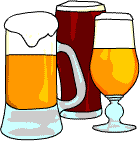Beer Glasses
Created | Updated Jun 14, 2007

The shape and style of a glass affects the taste and appearance of the beer that is drunk from it. This is why, if travelling and drinking in countries such as Belgium where the range and styles of beer vary dramatically, you will find a host of different sorts of glasses.
Most European bottled beers have their own sort of glass with their logo emblazoned on the side. At first glance this merely seems like a good advertising idea and in some cases it's purely for that reason. But mainly it's so the flavour of the beer is enhanced.
Shapes and Sizes
Beers such as ales should come in a glass with a wide mouth so that the floral aromas go straight through the nasal passages to excite the olfactory senses and complement the taste each time a sip is taken.
Lagers should be served cold to refresh the taste buds each time the glass is raised. So, to reduce the rate at which the beer warms up, the glass should have either a handle or a stem. A good example of this is the stein from Germany1. Not only do steins have handles but are often made from ceramic for extra insulation.
The shape of the glass also affects the head that tops the beer. A glass that is wide near the base and narrows toward the top will force the bubbles in the head together, bursting the larger ones and leaving a tighter, smoother head. Whereas a glass that widens toward the top will widen the surface area of the head allowing larger bubbles to form, giving a lighter, frothier topping or even letting it disappear altogether.
Another trick employed by breweries to control how the beer is served to the customer is by roughening the base inside the glass. The gas diluted in the beer reacts with the roughness and forms into a steady stream of little bubbles ensuring a constant head all the way to the end of the beer.
So the next time you see all these different styles of glasses you'll realise that they are actually there for a reason and are not the result of a demented glass blower.

